|
|
| |
| 1931 Bentley 8 Litre |
|
|
Original 1932 Numbers
Chassis
No. YX5105
Engine No. YX5105
Registration No. GX 38
|
|
This car - updated
Chassis No. YX5105
Engine No. YX5105
Registration No. GX 38
(Updated with information from RM Sotheby's. - August 2013) |
|
| |
|
|
 |
| August 2013 |
| Click
on thumbnail for larger view |
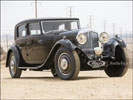 |
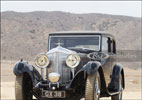 |
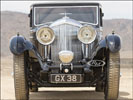 |
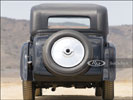 |
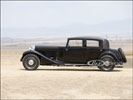 |
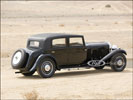 |
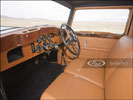 |
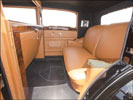 |
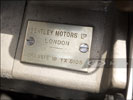 |
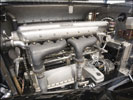 |
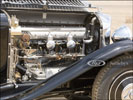 |
|
|
| |
 |
| |
Found on RM Sotheby's website
Sold For $825,000
Inclusive of applicable buyer's fee.
RM Sotheby's - Monterey 16 - 17 August 2013
1932 Bentley 8-Litre Saloon by Arthur Mulliner
Chassis No. YX5105 ~
Engine No. YX5105
- A pure example, retaining its original chassis, engine, and body
- The ninety-ninth of one hundred 8-Litre Bentleys constructed
- A wonderful closed example for show or comfortable touring
The 8-Litre was basically an enlarged version of the Speed Six. It had a newer and lower chassis with out-set rear springs and an F-series gearbox, which differed from all previous Bentley designs as its casing split down the center, as opposed to the square box with a lid on top, which was used in all the earlier cars. This layout allowed for larger bearings, which provided extra strength and reduced engine noise.
The first 8-Litres appeared at the Olympia Motor Show in October 1930 and created a sensation. This magnificent machine would top 100 mph with heavy limousine coachwork and eight passengers inside!
Bentley’s Sales Manager Arthur Hillstead wrote in his book, Those Bentley Days, “Eight litres! Nearly three times the cubic capacity of the never-to-be-forgotten 3! And what a motor it was! Having a six-cylinder engine with a bore and stroke of 110 mm by 140 mm, respectively, and a top-gear speed range (with a ratio of 3.5 to 1) of a minimum of 6 mph and a maximum of 104 mph—what more could man ask for? Yes, indeed, and add to that an acceleration capacity of 10 mph to 100 mph in 50 seconds with a fully equipped saloon body, and surely we had the answer to the sporting motorist’s prayer. The sporting motorist! Speed cum refinement in its highest form! A creation evolved from years of racing experience!”
The 8-Litre was clearly aimed to go head-to-head with the Rolls-Royce Phantom II, and Hillstead was impressed by the fact that, while the Bentley outperformed the supercharged Mercedes of that time on both acceleration and maximum speed, “it performed with a silence that was uncanny.” He said, “There was nothing like it in the world.”
It would have been interesting to see what developed in this rivalry, but Bentley was, by now, in deep financial trouble. Bentley Motors effectively ended in 1931, when they notified London Life that they would be unable to make their June 30th mortgage payment. W.O. was confident that the company would continue under the proposed new ownership of Napiers, of Acton, London. The receiver’s sale of Bentley’s assets was regarded to be a formality, but in the Royal Courts of Justice in London’s Strand, a barrister representing the British Central Equitable Trust made a counter offer, much to everyone’s astonishment. Napier immediately offered more, but the judge informed the court that he was not an auctioneer and gave the two parties until 4:30 p.m. to come back with sealed bids. W.O. said, “I don’t know by how much precisely Napier were out-bidded, but the margin was very small, a matter of a few hundred pounds. All I knew that evening was that the deal would not be going through after all.”
Later, W.O. commented on the bankruptcy. He said, “When people ask me (and they are too tactful to do so often) why Bentleys went bust, I usually give three reasons: the slump, the 4-Litre car, and the ‘blower’ 4½; in proportions of about 70, 20, and 10%, respectively.” Following the court case, it became apparent that the B.C.E.T. was representing Rolls-Royce. Having acquired all of Bentley’s assets, including the design of the 8-Litre, it is telling that the model was never again produced.
Chassis YX5105 was dispatched to its first owner, Major C. Cooper, in April 1932. Ordered as a saloon, it is a long-wheelbase example with a massive chassis length of 156 inches, or 13 feet! It was in the United Kingdom until 1999, reportedly spending the last 35 years of that time in storage. Disinterred from its decades-long slumber, this aluminum-bodied saloon by Arthur Mulliner was found to be in excellent original condition, and it made its way to a collection in Florida. The new owner only deemed it necessary to commission a repaint, and it remained in that largely original condition until being acquired by its current owner in 2006.
Fortunately, the owner’s original intentions of commissioning a more rakish open body for the powerful chassis were scrapped upon his recognizing the desirability and intrinsic worth held by the relatively small number of pure remaining examples. Opting to preserve the integrity of the car as it was delivered to Major Cooper, YX5105 was first sent to Robert Aubrey, of Custom Classic by Aubrey in Lancaster, California.
The body was removed from the rolling chassis, stripped to bare metal, and fully refinished with multiple layers of deep black paint that were sanded in between applications, resulting in an exceptional, smooth finish. In keeping with the desired high quality of the restoration, the leather top was replaced and over 400 individual pieces of chrome were sent to be replated for consistent finish and appearance throughout. Every piece of glass was replaced, as were all of the corresponding gaskets and seals. The sumptuous leather interior was refinished in biscuit hides, with complementing deep black carpeting and headliner. All of the exquisite burled wooden trim was, of course, refinished and bears a finish that is as smooth as glass.
The rolling chassis and drivetrain was sent to Rick Hamlin, of Rick’s Auto Restoration in Wellington, Kansas, who is a well-known specialist in Rolls-Royce Silver Ghosts and W.O. Bentley automobiles. All mechanical aspects of the car were rebuilt by Hamlin, including the suspension, engine, and transmission, and all bearings and worn out items were replaced, so that the Bentley could be driven in the spirited fashion in which it was conjured into existence by W.O. himself.
Before it was time for the body to rejoin the chassis, the chassis was refinished in keeping with the high standards of the restoration. As presented, rolling on Rudge wire wheels with black paint-detailed Ace wheel discs and shod with Michelin blackwall tires, this 8-Litre Bentley is a tremendous, imposing sight to behold. It can provide the thrilling 100-plus mph performance as originally intended, and as a closed example, it would be ideal for long-distance touring in such rallies as those organized by the Bentley Driver’s Club, the Classic Car Club of America, or any number of North American or European-based organizations. The fact that it has not been shown also leaves the opportunity for an inaugural presentation at any number of events, where the throaty sound of its rumbling exhaust will be welcomed. |
|
| |
|
|
| |
|
|
| |
Source:
RM Sotheby's
Posted: May 14, 2020 |
|
| |
|
|
|
|
 |
|
|
 |
 |
| 2006 |
| In
USA in 2006 / Owned by a BDC & RROC member |
 |
|
 |
| Click
on thumbnail for larger view |
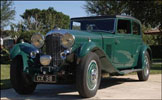 |
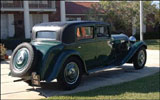 |
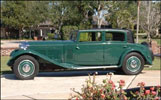 |
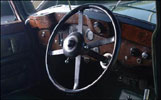 |
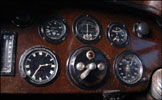 |
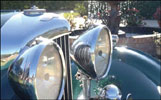 |
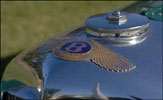 |
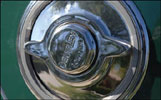 |
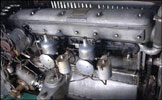 |
|
| |
 |
| |
"Coachwork by
Arthur Mulliner
220bhp at 3.500rpm, 7,983cc, overhead
camshaft inline six-cylinder engine,
four valves per cylinder, dual carburetors
and four-speed manual transmission.
Wheelbase: 156"
Coming up with the short list of great
true classics one thinks of the Duesenberg
Model J, the Packard 12, the Cadillac
V16, the Rolls-Royce Phantom I and
of course the Bentley 8 Liter. The
8 liter was an extension of the immensely
successful 6.5 liter powerplant that
earned Bentley an exceptional reputation
on the race track. However the Eight
was not looking for competition on
the track but rather was a focused
effort aimed squarely at dethroning
Rolls-Royce from their pedestal as
offering the best in British luxury.
The short wheelbase 144 in. Bentley
8 liter was as long as the short wheelbase
Rolls-Royce Phantom I, but the long
wheelbase 156 in. was exactly half
a foot longer than the longest comparable
Rolls-Royce. Size came at a price
paid in weight, 3,700 pounds for the
chassis alone, and a full-bodied car
could top the scales at over two tons.
Bentley had engineered a double-dropped
frame with seven tubular cross members
to support their colossal new design.
Bentley’s extensive use of aluminum
castings in the drivetrain displayed
their awareness of weight issues and
accordingly, engineers did all they
could to remedy the problem.
For a stout car, the Bentley 8 Liter,
even in formal coachwork was incredibly
brisk, capable of 100mph, while the
Rolls-Royce even in lightweight coachwork
had difficulties attaining 90mph.
The 8 Liter found a well-polished
list of customers and equally impressed
the automotive scribes of the era.
An article printed in The Autocar
in 1930 recounts a road test conducted
on the Eight:
Had it been that the performance made
the car difficult to handle on top
gear at low speed, difficult to maneuver
in traffic or in a confined space,
harsh or noisy, then the performance
by itself might be justly regarded
as simply that of a sports car, though
few of these features are easily noticeable
even in the modern sports car, unless
it has been tuned for racing. Quite
on the contrary, this car can be driven
really softly on its high top gear,
as slowly as a man walks, and can
accelerate from that without snatch
and without difficulty, and the whole
time the engine, being well within
its power, is silent and smooth. In
fact, it is only rarely apparent that
there is a big engine working under
the bonnet at all, and that so high
a top ratio is used, when the machine
is accelerated from a crawl. For all
practical purposes, therefore, the
machine does its work on the one gear.
Despite beautiful proportions, excellent
custom coachwork and the most capable
British engine, the timing of the
Bentley could not have been worst
as it coincided with the Great Depression
and the ensuing years just as it was
being felt around the world. There
were great costs involved with bringing
the 8 Liter into production, and as
resources continued to thin so did
the market for the car. Eventually
Bentley's chief financier, the great
Woolf Barnato, in pecuniary trouble
himself cut his loses and severed
his ties with Bentley.
After only 100 examples of the 8 Liter
were built, Bentley was forced to
cease production. To ensure that the
Bentley threat would never resurface,
Rolls-Royce pulled Bentley out of
receivership, and created a whole
new line of Bentleys that would serve
as entry level cars into the ultra
luxury department. Bentley was not
dead, but it would never build a car
as significant as the 8 Liter again.
The Bentley 8 liter presented here
was delivered to a Major C. Cooper
in April of 1932. It is a matching
numbers example with an aluminum body
and custom Saloon coachwork by Arthur
Mulliner. Built to British specifications
and delivered new in the UK, this
car resided in England until it was
acquired by an American collector
in 1999. After a thorough inspection
by Rick Carroll Restorations of Jensen
Beach, Florida it was decided this
highly original car needed only a
repaint to return it to very presentable
condition.
Post restoration, this car has been
used sparingly and is reported to
be in fine mechanical order, running
and driving quite well. The interior
still wears its original green leather
seats with inflatable rubber bladders
for adjustable firmness. The wood
trim inside is all original as is
a partial tool set fitted inside the
trunk. As one would expect the 8 Liter
has a roll up divider between the
chauffeurs cabin and the passenger's
compartment as well as lovely woodwork
and detail throughout the interior.
The Bentley 8 Liter is the best of
its breed; it was in every way a remarkable
car during its era, with all the ingredients
that continue to garner international
appeal today. Just as they did when
new, the 8 Liter continues to reward
its drivers and occupants with an
experience that has never truly been
recreated; very few cars were ever
made that were as pleasurable to drive
and own while offering a fit and finish
worthy of royalty. With a very active
organization in the Bentley Drivers
Club in both the US and overseas,
there are plenty of events tailored
strictly for the Bentley marque including
the North American Vintage Bentley
meet. Truly a handsome example, this
8 Liter represents excellent value
given the mechanical and cosmetic
fitness and overall rarity." |
|
| |
|
|
| |
|
|
| |
Source:
RM Auctions Inc.
Posted: Feb 21, 2006 |
|
| |
|
|
|
|
 |
| Click
on thumbnail for larger view |
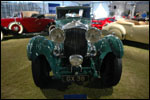 |
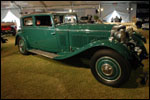 |
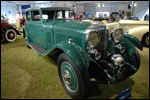 |
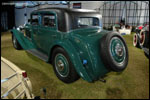 |
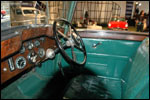 |
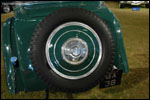 |
|
| |
 |
| |
The 8-Litre Bentley
For sheer impressive presence, few
cars can match the 8-litre Bentley.
The next logical development of Bentley's
race-winning 6.5-litre engine, the
8-liter was designed to be a challenge
to the Rolls-Royce Phantom in the
luxury market.
The buyer had a choice of a 144 inch
or 156 inch wheelbase chassis with
a massive double-dropped frame, connected
by seven tubular cross members. Such
construction, despite the generous
use of aluminum castings for many
drivetrain components, resulted in
a 3,700-pound weight for the chassis
alone! Closed cars surpass 2.5 tons
depending on the coachwork, while
open examples still exceeded two tons.
It was fair to say that the Bentley
8-litre was the British equivalent
of the Model J Duesenberg; its tall
radiator and grille actually carry
a better-than-passing resemblance
to the 'Big D' from Indianapolis.
And with a top speed of 100-plus mph,
even with formal coachwork, the Bentley
would put up a very good account of
itself on the road compared to the
Duesy.
Despite its outstanding specifications
and performance, however, it was the
8-liter that did in Bentley Motors
financially. Developed and announced
just as the worldwide Depression was
beginning to bite, this model stretched
Bentley's thin resources past the
point of fiscal prudence at a time
when its principal backer, Woolf Barnato,
was experiencing some financial reverses
of his own and pulled the plug on
his Bentley investment.
The sad result was that after only
100 examples of the 8-liter rolled
out of the Bentley works, production
came to an end. Ironically, not much
time passed before - rather than beating
Rolls-Royce at the luxury game - Bentley
ended up being bought by its archrival.
A glance at the mechanical specifications
noted above would confirm the 8-liter
Bentley's status as one of the supercars
of its time. Its original customer
list, too, would confirm that these
marvelous cars appealed to - and could
only be afforded by - the privileged
few. Among the buyers were 'Jock'
Whitney, head of the New York Stock
Exchange, HRH the Duke of Kent, Lord
Brougham and Vaux, the Duke of Leinster,
France V. DuPont, W.W. Astor, William
K. Vanderbilt and, naturally, Woolf
Barnato.
The custom bodies were supplied by
a 'Who's who' of coach builders including
Vanden Plas, Kellner, Thrupp and Maberly,
Arthur Mulliner, Gurney Nutting, Park
Ward, Freestone & Webb, Letourner
et Marchand, Binder and Walter J.
Murphy. The majority of coachwork
was closed and formal with less than
25% of the minuscule output equipped
with open bodies.
This Car
Delivered to a Major C. Cooper in
April 1932, this aluminum-bodied matching-number
example spent from that time until
1999 in the U.K., the latter 35 years
in storage. The present owner purchased
it in 2001 and found it to be in such
good original condition that only
a metal-up repaint by Rick Carroll
Restorations of Jensen Beach, Fla,
was required to put the car in a highly
presentable state once again.
The owner reports that the engine
and drive-train are in good operating
condition throughout and that the
interior retains its original green
leather seats along with the inflatable
red rubber bladders in the seats that
may be adjusted for firmness. It is
equipped with a roll-up divider window,
and the original wood trim in the
passenger compartment is also original
and exceptionally attractive. A partial
original tool set is fitted in the
trunk.
Here is a motorcar with great international
appeal and an enviable heritage that
few automobiles can match. From its
sophisticated mechanical specifications
to the marque's LeMans-winning history,
both then and now, this car represents
the ultimate development of the vintage
Bentley under the direction, planning
and thinking of the great Walter Owen
Bentley himself. It is eligible for
any number of prestigious events including
most important concours here and abroad,
the annual North American Vintage
Bentley Meet, all the activities of
the venerable Bentley Drivers Club
in the U.S. and overseas, as well
as the Classic Car Club of America.
Year: 1932
Make: Bentley
Model: 8-Litre
Engine Location: Front
Drive Type: Rear Wheel
Production Years for Series:
1930 - 1931
Coach Work: Mulliner
Weight: 5600 lbs | 2540.2 kg
Introduced At 1930 London Motor Show |
|
| |
|
|
| |
|
|
| |
Source:
ConceptCarz
Posted: May 02, 2006 |
|
| |
|
|
|
|
|
|
 |
| EARLIEST
RECORD OF HISTORICAL FACTS & INFORMATION |
 |
 |
| |
| Chassis No. |
YX5105 |
| Engine No. |
YX5105 |
| Registration
No. |
GX 38 |
| Date of Delivery: |
Apr 1932 |
| Type of Body: |
Saloon |
| Coachbuilder: |
Arthur Mulliner |
| Type of Car: |
13  |
| |
|
| First Owner: |
COOPER Major C |
|
|
| |
|
|
| |
More Info:
Michael Hay, in his book Bentley:
The Vintage Years, 1997, states:
"F/8091." |
|
| |
|
|
| |
|
|
| |
Posted: Mar 01, 2007 |
|
| |
|
|
|
|
| |
| |
| |
| Submit
more information on this car |
| |
| |
| |
|
|
| |
| |
| |
 |
| |
| |
|
| |
|
 |
 |
 |
Sep 30, 2020 - Info and photograph received from Simon Hunt for Chassis No. RL3439 |
 |
 |
Sep 30, 2020 - Info and photographs received from Dick Clay for Chassis No. 147 |
 |
 |
Sep 29, 2020 - Info and photographs received from Ernst Jan Krudop for his Chassis No. AX1651 |
 |
 |
Sep 28, 2020 - Info and photographs received from Lars Hedborg
for his Chassis No. KL3590 |
 |
 |
Sep 25, 2020 - Info and photograph added for Registration No. XV 3207 |
 |
 |
Sep 24, 2020 - Info and photograph added for Registration No. YM 7165 |
 |
| [More] |
 |
|
|
|
 |
|
|
 |
 |
 |
|
CLUB TALK
Upcoming Vintage Bentley Events |
 |
|
|
 |
 |
 |
|
|
 |
| |
|